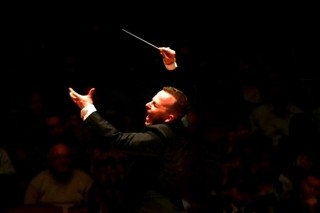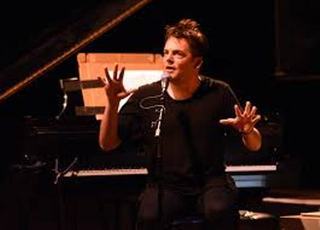|
Back
Largesse From Mr. Nézet-Séguin New York
Isaac Stern Auditorium, Carnegie Hall
05/14/2015 -
Nico Muhly: Mixed Messages (New York Premiere)
Ludwig van Beethoven: Piano Concerto No. 3 in C Minor, Opus 37
Sergei Rachmaninoff: Symphony No. 3 in A Minor, Opus 44
Emanuel Ax (Piano)
The Philadelphia Orchestra, Yannick Nézet-Séguin (Music Director and Conductor)

Y. Nézet-Séguin (© The Philadelphia Orchestra)
Hand it to that exuberant conductor of the Philadelphia Orchestra, Yannick Nézet-Séguin. Last night’s program had something for everybody. A mainstream concerto played by one of the world’s great pianists? You got your wish. A lush late Romantic symphony? Check it out. And for those few who wanted the newest pyrotechnics from the most prolific (and eclectic) composer of our times, the fireworks were turned on from the beginning.
Plus, if Mr. Nézet-Séguin was the God of the podium, distributing largesse to believers in the audience, he could punish a few evildoers as well.
That we come to in a moment.
But the opening work was the most appropriate for a conductor of Mr. Nézet-Séguin’s decorum. No matter what the music, he never lets his baton rest. The Philadelphia Orchestra had a fine musical director in Eugene Ormandy–but the pizazz, the hoopla, the color came from Leopold Stokowski. And Mr. Nézet-Séguin is in that Stokowski league. To a deaf viewer, he might seem histrionic. But those with ears to hear can spot the spot-on precision of the Philadelphia Orchestra, responding to his every command. Evidently, Mr. Nézet-Séguin does not hide his excitement, and it seems to infect every member of the orchestra.

N. Muhly (© En.wikipedia.org)
Which must have amply gratified Nico Muhly. His latest work for the Philadelphia Orchestra, Mixed Messages has an excellent description in the program, showing how the themes interact, reiterate, cancel themselves out and “learn from each other.” All of which is obviously true, and could easily be figured out with a score and a second hearing.
What Mr. Nézet-Séguin produced for a first hearing, though, was a whip-lashing miracle of music, starting off with what could have been the opening of Berlioz’ Roman Carnival Overture. What came next were 11 minutes where the Philadelphia Orchestra set a crackling pace, each consort of instruments starting melodies, fracturing them, passing them onto other soloists or consorts.
Add to that (and much easier to hear) were the pulsing rhythms. Again , this was an illusion. The Steve Reich-style throbbing was broken up, returned, the symmetrical stretching itself, turning the meter on its side, then back again.
Mr. Muhly, whose eclecticism ranges from Rufus Wainright to the Metropolitan Opera, here produced fireworks, yes, but far more. He played with a romantic themes (almost schmaltzy cellos), but it was not a parody: it was a paean. The predominant sounds were explosions conflicting, infecting and duplicating themselves. A delight to hear. But yes, that technicolor painting probably did hide more interesting elements underneath.
Mr. Muhly wrote Mixed Messages this year at the age of 33. Ludwig van Beethoven was also 33 years old when he wrote the Third Piano Concerto. But one would be foolish to compare the young ebullience of Mr. Muhly with the Promethean laughter of Beethoven.
Nonetheless, Emanuel Ax, his shaggy exterior belying the most fastidious of artistry, allowed Mr. Nézet-Séguin to give a volatile introduction before he plunged into a most personal–not idiosyncratic but personally felt–first movement. The Philadelphia Orchestra stayed in the background, not because it was simpler to accompany. Mr. Ax inevitably predominated with a most endearing, wondering amiable performance, ending with a cadenza played so beautifully it could have turned into a solo sonata.
The second movement had all the right serenity. But in the Allegro-Presto finale, Messrs Ax and Nézet-Séguin allowed themselves to go with the flow. The little jokes (Beethoven sticking in the First Symphony theme), the changes of tempo were never pushed. They played–and under Mr. Ax’s fingers–sang for themselves.
The second half was devoted to pure romanticism, Rachmaninoff’s Third Symphony. Next to the concision of both Muhly and Beethoven, the Symphony did outgrow its welcome at times. But from the first affecting cello theme to the inevitable Dies Irae, the composer showed, as always, more than prettiness. And Mr. Nézet-Séguin threw himself into the music, pulling out the emotion, bursting open the slow movement center, and ending with a fugue which showed his orchestra at its silky smoothest.
***************
CODA: I mentioned above that Mr. Nézet-Séguin punished some miscreants in the audience. These were the latecomers after the intermission who sauntered into their rows just as the conductor was raising his baton.
That, though, would never do for the impulsive Mr. Nézet-Séguin. He glared at them, put down his stick, took a seat on the side of the dais, and watched them amble down the aisle. When more of them appeared, he stood up and walked to the other side of the dais and sat and waited again and he commenced.
Being God does have its opportunities. And I kinda wish our other gods of the podium could shame transgressing audiences how to behave.
Harry Rolnick
|